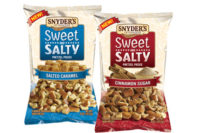Beyond the Borders

By Marina Mayer
It’s been a long time since tortillas were considered a phenomenon south of the border. It’s been years since they have been exclusively associated with Mexican food and categorized as a soft-shell taco. In fact, tortilla manufacturers are making the tortilla a viable contender to sliced bread in many homes.
Thanks to consumer awareness and product flexibility, tortillas are now venturing into new borders both in restaurants and in kitchens across the nation. The nutritional benefits and mix-and-match recipes of tortillas allow chefs and consumers to switch up their meals to make for a healthier, but still tasty, entrée.
For tortilla makers, it’s all about “versatility.”
“Most people equate a tortilla when they eat Mexican foods; if we have the ability to share recipe ideas of the different things that tortillas can be used for, folks can incorporate [tortillas] into their daily lives,” says Ricardo Baez, executive vice president at Don Pancho Authentic Mexican Foods, Inc., Salem, Ore.
“We want to champion the flexibility of what you can do with a tortilla wrap,” he adds.
Well what can you do with a tortilla wrap?
Don Pancho’s Web site provides menu suggestions that range from your conventional tortilla-based meals such as chicken enchiladas and taquitos Mexicanos to more innovative meal solutions such as tortilla sundaes, which consist of deep-fried tortilla shells shaped like a cup, then filled with fruit slices, ice cream, whipped cream, nuts and ice cream toppings.
“We manufacture a certified-organic wrap and we actually have a third party agency that certifies the product,” Baez explains.
Likewise, Chicago-based Azteca Foods’ Web site offers everything from baked apple puffs to hot corned beef wraps. A wrap is versatile in that you can eat a peanut butter and jelly sandwich on a tortilla shell instead of bread or prepare a Mexican pizza in just five minutes because you’re working with tortillas versus pizza dough. You can even make French toast strips topped with an assortment of fruits rolled in a wrap. Initially these recipe suggestions may seem convention continued culinary borders, but in the tortilla world, some things can be all things to all people.
And while Taco Bell commercials ring “think outside the bun,” tortilla manufacturers are thinking outside of the shell. If you’re a carb-addict, getting accustomed to tortilla-based meals will be like switching from 2% milk to soymilk overnight, but the so-called bread substitution isn’t just a result of convenience and versatility. Consumers are in search for healthier, more organic ways of eating.
According to Renee Togher, Azteca’s vice-president of retail marketing and sales, “tortillas made out of whole grains, organic ingredients and are otherwise nutritionally fortified satisfy a growing niche of health-conscious consumers.”
Surveys are telling her that the chip and dip fad of tortillas is off the picnic table. People are turning to tortillas because of the health benefits they receive when doing so.
Louis Guerra, CEO of Rudy’s Tortillas, Dallas, states, trans-free, whole grain and multi-grain are fueling sales.
“What’s ‘in’ is food that doesn’t cost substantially more to offer you a healthy alternative,” he says. “Tortillas can fill that niche as they offer portability, convenience and a variety [of] flavor profiles. What’s ‘out’ is tortillas made from animal fats like lard, and other ingredients that have proven themselves to be unhealthy. Tortillas can be made from cleaner oils and still taste home-made.”
Because the Atkin’s craze and other anti-carb diets don’t rule the menus and grocery aisles, tortilla manufacturers are continuing to enhance the ingredients used to make healthy tortillas by incorporating omega-3 nutrients and whole wheat fibers.
“Whole wheat has moved up substantially, as well as white whole grain tortilla that looks the same as a regular white flour tortilla, but is made from white whole wheat,” explains Guerra.
But when you flip the tortilla over, rising commodity costs of corn, wheat flour and oil are still a challenge that even versatility and healthy eating can’t overcome.
“Like most food producers who use wheat, corn and oils as primary ingredients, we have no choice but to raise our prices and intensify our expense reductions and productivity projects,” Togher says.
Guerra adds that tortilla producers are being hit on all sides by skyrocketing commodity prices.
“All corn tortillas, flour tortillas and fried taco shells and chips need these commodities,” he says. “All three are trading at historic highs. All three show no sign of decreasing anytime soon…this has forced many small tortilla factories to abandon their dreams of growing their small enterprise to keep up with the large tortilla demand.”
However you flip it and wrap it up, it seems as though the tortilla market is expanding as the product is incorporated into a greater variety of meal solutions. It’s difficult to compete with a product that brings so much more to the table, literally.
Looking for a reprint of this article?
From high-res PDFs to custom plaques, order your copy today!






